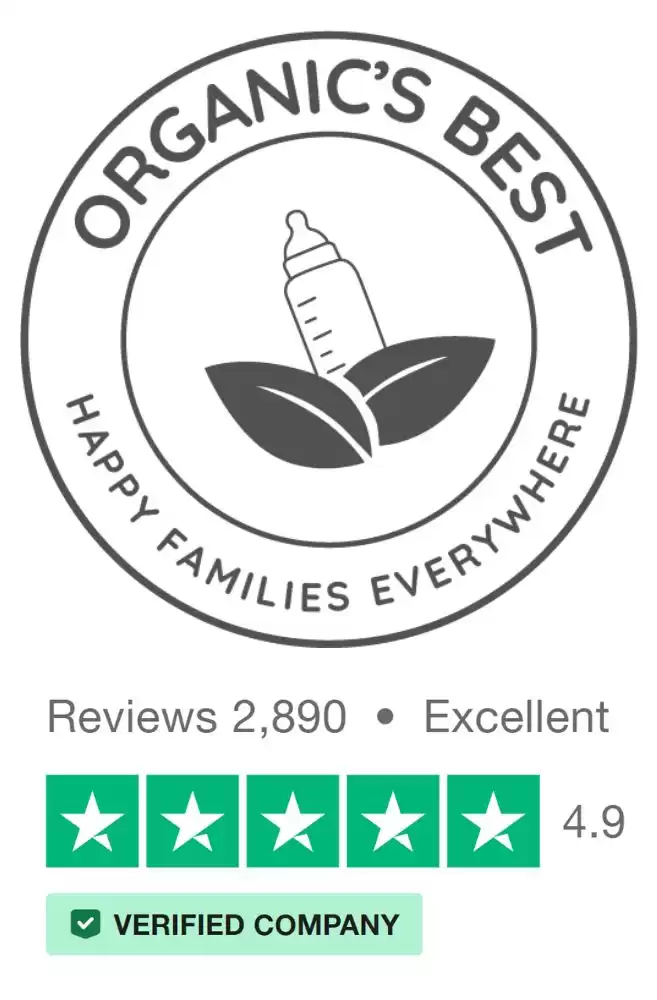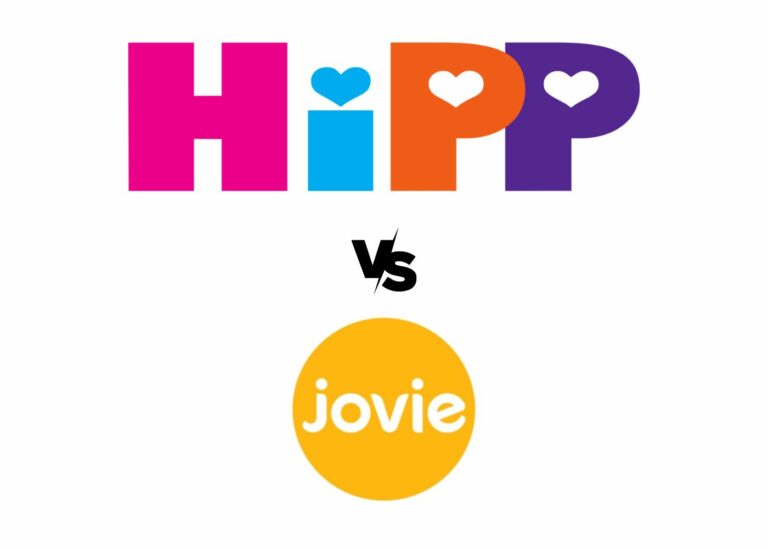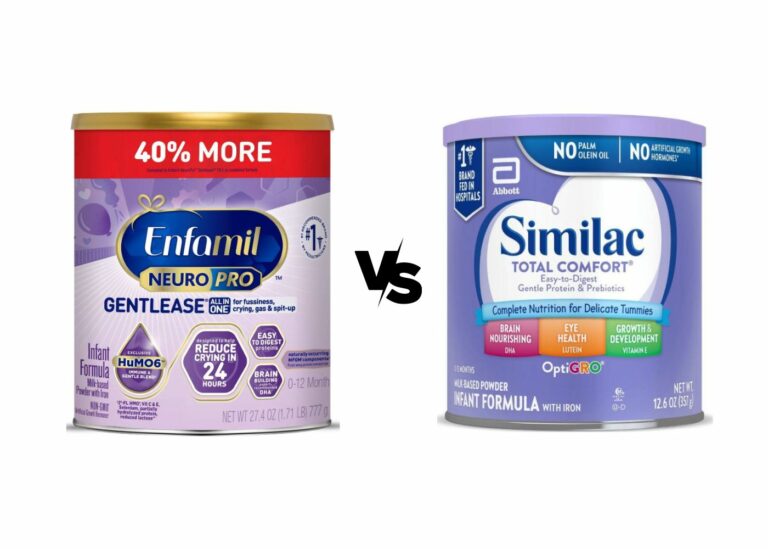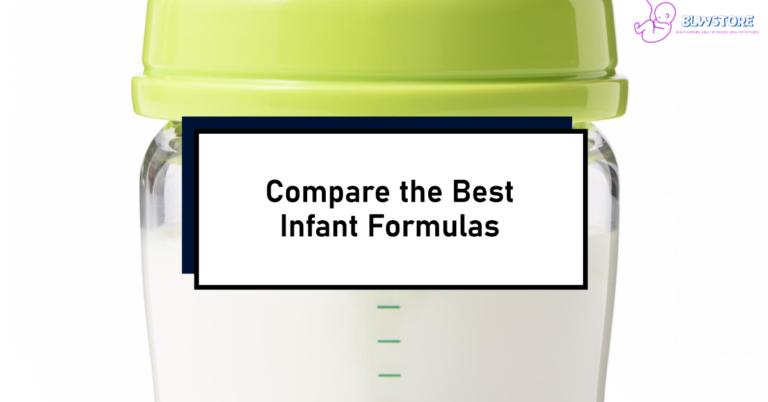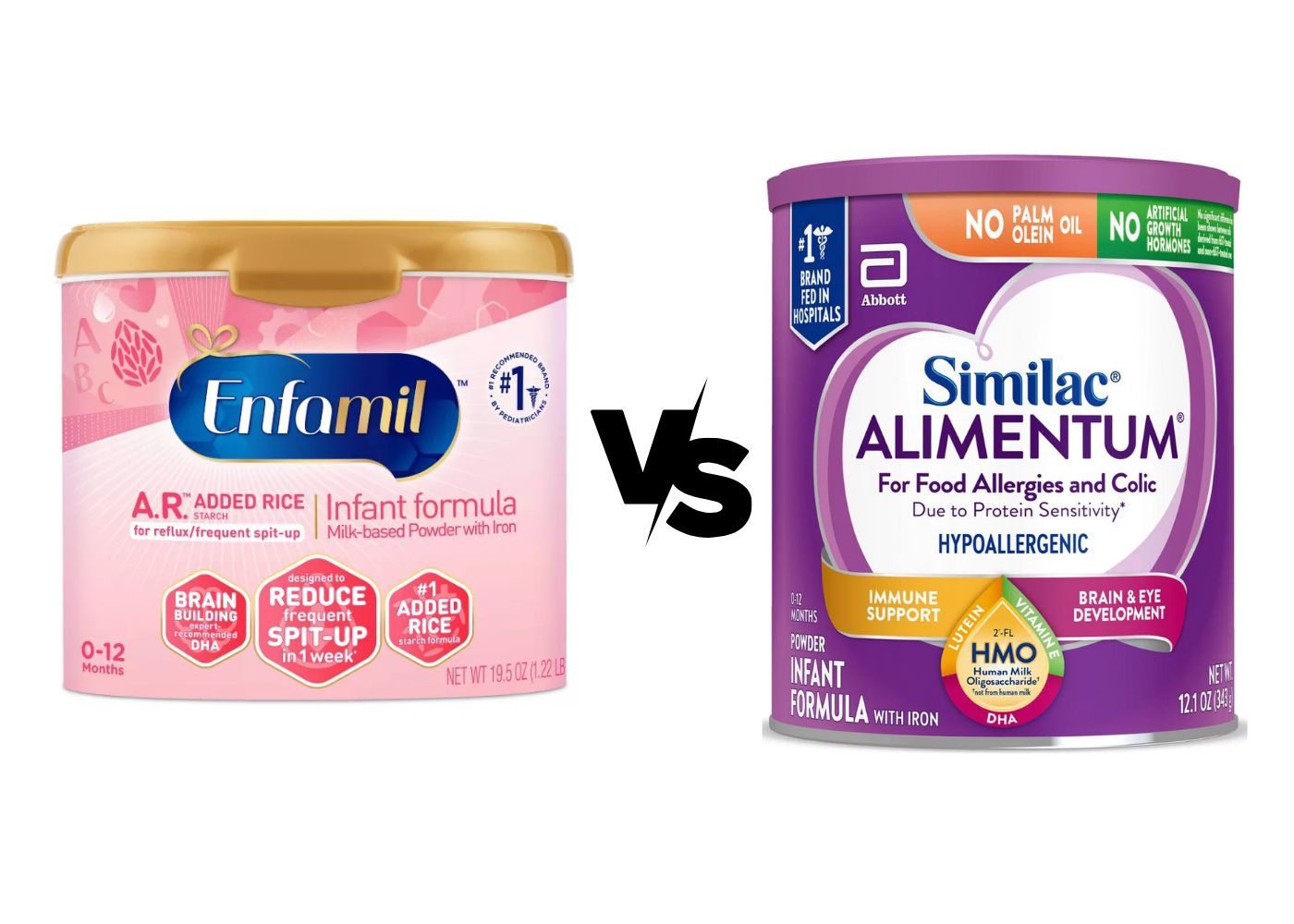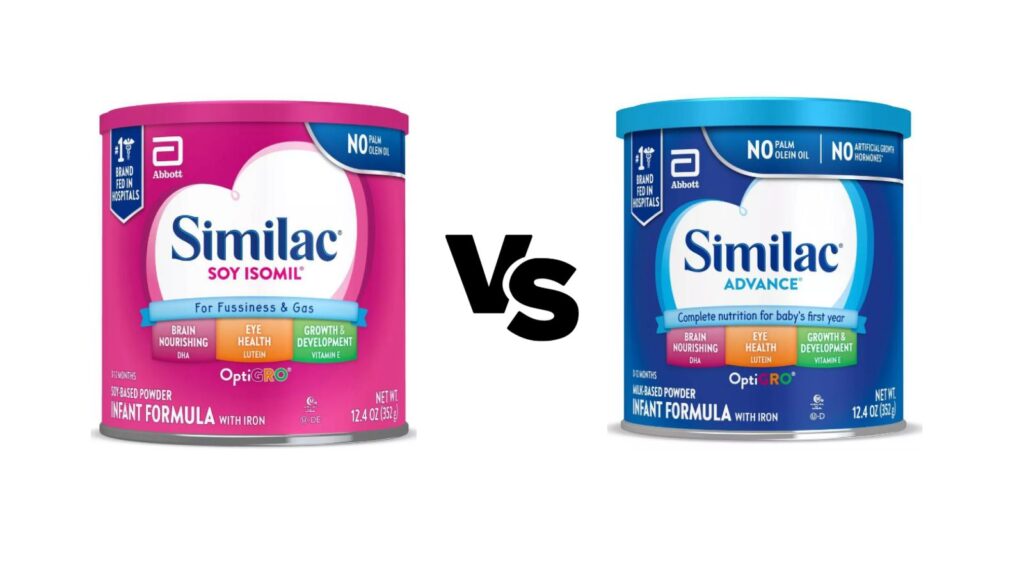
Key Differences Table Between Similac Soy and Similac Advance
| Features/Aspect | Similac Soy (Isomil) | Similac Advance |
|---|---|---|
| Ideal For | Babies with lactose intolerance or on a vegetarian diet | Babies from 0 to 12 months without special dietary needs |
| Type | Soy-based formula | Milk-based formula |
| Primary Protein Source | Soy protein isolate | Nonfat milk and whey protein concentrate |
| Carbohydrate Source | Corn syrup solids | Lactose |
| Fats and Oils | High oleic safflower oil, soy oil, coconut oil | High oleic safflower oil, soy oil, coconut oil |
| Nutritional Benefits | Fortified with DHA, vitamins, minerals | Enriched with DHA, Lutein, vitamin E, and OptiGRO™ |
| Ease of Digestion | Designed for easy digestion, suitable from birth to 12 months | Tailored for overall growth and development, supports brain and eye health |
| Special Dietary Considerations | Suitable for lactose intolerant and vegetarian diets | Suited for babies without dietary restrictions |
| Prebiotics | Short-Chain Fructooligosaccharides (scFOS) | Galactooligosaccharides (GOS) |
| Specific Benefits | Lactose-free, dairy-free, complete nutrition | Milk-based, comprehensive growth nutrients, OptiGRO™ blend |
This article will compare two popular Similac Formulas: Similac Soy vs Similac Advance.
We will analyze their nutritional composition and ingredients to help you make the best decision for your baby.
Let’s get after it!
***Important: Soy formulas are not recommended for infants younger than six months of age due to estrogen content and should not be used to treat CMPA until a pediatrician gives the okay.
Our Short Answer
The choice between Similac Soy and Advance will depend on your baby’s needs.
Choose Similac Soy if your baby:
- Is at least 6 months old and a pediatrician has given the OK to use soy formula.
- Is lactose intolerant
- Has cow’s milk protein allergy
Keep in mind that if a baby has CMPA, soy protein may also trigger allergies.
Choose Similac Advance if:
- Your baby is between 0 and 12 months old
- Does not have any special digestive needs
That said, we recommend you take a look at the alternatives to both formulas, further down in the article, as although Similac is a recognized brand, there are other healthier options.
With over 100,000 orders delivered globally since 2019, Organic's Best offers clean, safe, and nutritionally rich formulas and snacks.
Free shipping over $100, commitment to freshness and authenticity.
- Express delivery in 2 to 5 business days
- Sourcing from European manufacturers
- Minimum shelf life of 6 months
- Climate-Controlled Warehouse
Give your little one the best start.
CODE 'BLW' for a 5% discount in all orders
Overview of the Two Formulas
Similac Soy Isomil, a dairy-free formula with soy protein isolate, caters to lactose intolerant babies and those with galactosemia, offering complete nutrition including DHA.
Similac Advance, a milk-based formula, is suited for babies without dietary restrictions, enriched with DHA, Lutein, vitamin E, and OptiGRO™ for comprehensive growth and development.
Similac Soy
Similac Soy, formally known as Similac Soy Isomil, is designed for families who are seeking a vegetarian or dairy-free option for their infants. Let’s look at the features that make Similac Soy a potential choice for your baby:
- Dairy-Free: This formula uses soy protein isolate instead of cow’s milk, and it’s suitable for lactose intolerant babies, which may be appealing if your little one experiences discomfort with dairy-based formulas.
- Complete Nutrition: Similac Soy includes essential nutrients, such as DHA for brain development, as well as vitamins and minerals necessary for your baby’s growth. It’s a complete alternative to milk-based formulas in terms of nutrition.
- Safety: Similac Soy is designed for babies with galactosemia or those who need to avoid cow’s milk protein.
- Familiar Brand: Similac is a reputable brand, well-known for its wide range of baby formulas.
Similac Advance
Moving on to Similac Advance, this is a milk-based formula that prioritizes providing a foundation that’s similar to breast milk, aiming to support your baby’s overall development:
- Milk-Based: Ideal for babies without special dietary restrictions, Similac Advance contains nonfat milk and whey protein concentrate.
- Nutritional Benefits: Similac Advance is fortified with an exclusive blend of vitamins and minerals, including DHA, Lutein, and vitamin E, which play a crucial role in supporting your baby’s brain and eye development.
- OptiGRO™: This nutrient-rich blend is unique to Similac formulas and supports your baby’s overall growth and development, mimicking some of the benefits found in natural breast milk.
Nutritional Composition
Similac Soy uses soy protein isolate, suitable for milk protein sensitivities or vegan preferences, but with lower bioavailability. Similac Advance features nonfat milk and whey protein, trying to mirror breast milk’s protein content.
Isomil’s carbohydrates are corn syrup solids, ideal for lactose intolerance, while Advance uses lactose, typical for standard formulas.
Both formulas have similar fat blends, with Advance having a slightly better DHA source for bioavailability.
Protein Content
Protein is the cornerstone of growth, crucial for building muscles, repairing tissue, and supporting overall development. Assessing protein content and its sources in baby formula can influence your decision based on your baby’s specific nutritional needs.
Similac Soy:
- Source: The protein in Similac Soy formula is derived from soy protein isolate, a plant-based alternative to dairy proteins.
- Hypoallergenic: Especially suitable for infants with milk protein sensitivities or families seeking a vegan option.
- Quantity: Soy formulas have higher amounts of protein because plant-based protein has less bioavailability than animal-based protein.
Similac Advance:
- Source: The protein in Similac Advance comes from nonfat milk and whey protein concentrate which aim to mirror the protein content of human breast milk.
- Balance: This formula maintains an optimal balance of whey and casein proteins to support infant growth and digestion. Its whey-to-casein ratio is 48:52.
- Advantage: With added OptiGRO™, Similac Advance proteins support brain development, contributing to a complex of nutrients that benefit infants in building foundational systems.
Neither formula could be further from each other in terms of protein. Isomil uses soy protein, suitable for babies with lactose sensitivity and cow’s milk allergy. However, plant-based protein has less bioavailability than animal-based; this means it’s used and absorbed by the body less efficiently.
Advance uses skimmed milk and whey concentrate, the standard for conventional formulas.
Carbohydrate Content
Carbohydrates offer essential energy infants need for all the exploration and learning they do through their early years.
Similac Soy:
- Source: The primary carbohydrate in Similac Soy is corn syrup solids, substituting lactose to provide energy in a digestible form for those with intolerances..
Similac Advance:
- Source: Lactose, sourced from cow’s milk, serves as the main carbohydrate in Similac Advance—offering a profile very similar to breast milk for energy production.
Again, very different types of carbs in both formulas. Isomil uses corn syrup solids and simple sugars as an alternative to lactose, which makes the formula suitable for lactose sensitivities and intolerance.
Advance, however, uses lactose, which is what we want to see in conventional formulas, designed for babies without any specific issues.
Fats and Oils
Fats are essential in a baby’s diet, crucial for the development of the brain and nervous system, as well as providing energy and aiding in the absorption of vitamins.
Similac Soy:
- Blend: A mix of high oleic safflower oil, soy oil, and coconut oil provides a balanced spectrum of essential fatty acids, omitting animal fats for those with dietary restrictions.
- Additives: Isomil also adds C. Cohnii Oil (DHA) and M. Alpina Oil (ARA).
Similac Advance:
- Combination: Similar to Similac Soy, Similac Advance comprises a blend of high oleic safflower oil, soy oil, and coconut oil, designed to mimic the fatty acid profile of breast milk.
- Additives: Special additives, such as DHA and ARA—long-chain polyunsaturated fatty acids—are included to support mental and visual development. (Schizochytrium Sp. Oil (Source Of Dha), M. Alpina Oil (Source Of Ara))
The fat blend in both formulas is the same, the only difference is in their source of DHA, which Advance has a slightly better oil in terms of bioavailability.
Prebiotics and Probiotics
Formulas with prebiotics and probiotics can support the development of a healthy digestive system and integrate seamlessly into daily nutrition for your little one. Let’s examine the presence of these ingredients in Similac’s formulas.
- Similac Soy: Similac Isomil contains Short-Chain Fructooligosaccharides, a prebiotic found in fruits, vegetables, and grains.
- Similac Advance: Advance contains Galactooligosaccharides (GOS), a prebiotic found in lactose that promotes gut health and immunity.
Best Places to Buy Similac Formulas
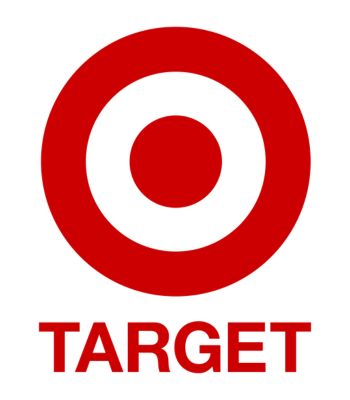

Similac Soy Isomil
Similac Advance
What are the Best Alternatives to Similac Soy and Similac Advance?
Every baby is unique, and finding a formula that suits their individual needs is paramount. If you’re exploring alternatives to Similac Soy and Similac Advance, whether due to preference or your baby’s dietary requirements, consider these commendable substitutes:
For Similac Soy:
- Enfamil ProSobee: This soy-based formula is an excellent alternative for babies who require a dairy-free option. *Read: Enfamil Soy vs Similac Soy
- Gerber Soy: Another soy protein-based choice, Gerber Soy, provides complete nutrition for infants with lactose intolerance or milk protein allergy. *Read: Gerber Soy vs Similac Soy
- Nutramigen and Alimentum Formulas: For infants with cow’s milk protein allergy (CMPA), these hypoallergenic formulas can be gentle alternatives that reduce colic symptoms related to CMPA, are easier to digest and promote overall gut health. *Read: Similac Soy vs Alimentum | Similac Soy vs Nutramigen
For Similac Advance:
- Kendamil: Touted as our top choice, Kendamil’s formula is noteworthy for using real human milk oligosaccharides (HMOs) and whole milk, aligning closely with the natural composition of breast milk. *Read: Kendamil vs Similac
- Bobbie: Recognized as the best US-Based brand, Bobbie offers a pure and simple ingredient list, with dairy sourced from USDA organic certified farms appealing to parents seeking a domestically-produced formula. *Read: Bobbie vs Similac
- Hipp: A great option for babies with sensitivities, Hipp’s formula is known for being gentle and using high-quality ingredients that cater to little ones with delicate tummies. *Read: Hipp vs Similac
- Holle: For parents prioritizing organic and natural components, Holle is an outstanding choice with Demeter certification—a strict biodynamic standard—ensuring a clean and pure formula blend. *Read: Holle vs Similac
Last Words
We hope this comparison between Similac Soy and Similac Advance has helped you make an informed decision.
If you have further questions, feel free to leave a comment below or contact us.
Happy feeding!
We’re Maria and Alberto, a married couple and educators who are nutrition enthusiasts. Even before we had kids, we were already crazy about nutrition.
We’d read scientific articles, watch videos from nutritionists, and spend hours listening to nutrition podcasts.
Today, we continue doing this, but in a different way, as we’ve learned to sift through the noise and trends. Nutrition, like any other field of knowledge, the more you read and learn, the more you develop a comprehensive understanding of reality, and that’s what has happened to us.
Before having our first child, we focused on learning everything we could about child nutrition, using the same techniques we had already employed, backed by our extensive knowledge in nutrition.
Our mission is to help other parents with their children’s nutrition, to help them become the best versions of themselves.
If we are what we eat and drink, which is absolutely true, let’s do it right!


